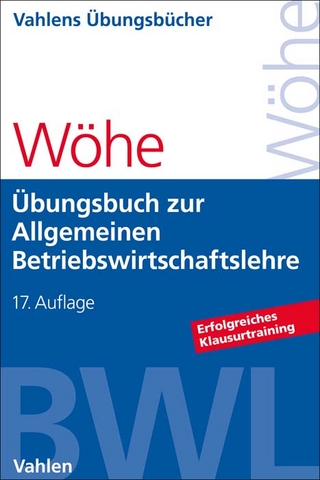Risk Takers
De Gruyter (Verlag)
978-1-5474-1609-7 (ISBN)
John E. Marthinsen, Babson College, MA
Chapter 1: Primer on Derivatives 1
What Are Derivatives? 1
Who Buys and Sells Derivatives? 2
Where Are Derivative Contracts Bought and Sold? 2
Two Major Types of Derivatives 3
Forward Contracts 3
Option Contracts 4
Forward Contracts 4
Long Forward in Action 5
Short Forward in Action 6
Options 7
Call Options 7
Put Options 8
American versus European Options 9
Examples of Puts and Calls in Action 9
4,000 Years of Derivatives 13
Conclusion 14
Risk Notepad 1.1: OTC-traded versus Exchange-Traded Derivatives 15
Review Questions 18
Bibliography 19
Chapter 2: Employee Stock OptionsA User’s Guide 21
ESOs: A Major Pillar of Executive Compensation 21
Why Do Companies Use ESOs? 22
Aligning Incentives 22
Hiring and Retention 23
Adjusting Compensation to Employee Risk Tolerance Levels 24
Employee Tax Optimization 24
Cash Flow Optimization 25
Option Valuation Differences and Human Resource Management 26
Problems with ESOs 37
Employee Motivation 38
Improving Performance 40
Absolute Versus Relative Performance 40
Possible Solutions to Employee Stock Option Problems 41
Premium-Priced Stock Options 41
Index Options 42
Restricted Shares 45
Omnibus Plans 45
Conclusion 46
Review Questions 46
Bibliography 47
Chapter 3: Metallgesellschaft AG Illusion of Profits and Losses, Reality of Cash Flows 51
Metallgesellschaft: Evolution of the Company and Its Product Lines 51
Energy Derivatives at MGRM 52
Energy Markets on a Roller Coaster 53
Risk Notepad 3.1: What Is the Difference Between Contango and Backwardation? 55
MGRM’S Innovative Energy Derivative Products 56
MGRM’s Embedded Options 58
Hedging MGRM’s Forward Energy Exposures 59
Payoff Profile of a Short Forward Position 59
The Ideal Hedge Was Not Available 61
Physical Storage Hedge 61
Stack-and-Roll Hedge 62
Cash Flow Effects of a Stack-and-Roll Hedge 64
Scenario #1: The Price of Oil Falls and Basis Falls for Two Consecutive Months 65
Stack-and-Roll Hedge Ratios 69
MG Calls It Quits 69
MGRM Butts Heads with NYMEX and the CFTC 70
MGRM’S Profitability: It’s All in How You Account for It 71
MGRM’S Credit Rating 72
The Effects of an Itchy Trigger Finger 72
Was MGRM Hedging or Speculating? 72
Corporate Governance Issues 73
Conclusion 74
Review Questions 75
Bibliography 76
Chapter 4: Swaps That Shook an Industry: Procter & Gamble versus Bankers Trust 77
P&G’s Motivation for the Swaps 78
Motives for the U.S. Dollar–Denominated Interest Rate Swap 79
Motives for the German Mark–Denominated Interest Rate Swap 80
Motives for Using the Over-the-Counter Market 80
The U.S. Dollar–Denominated Swap 81
Plain Vanilla Swap 82
P&G’s Gamble: The Speculative Side-Bet 83
Viewing P&G’s Speculative Side-Bet as a Short Call Option 84
Risk Notepad 4.1: Security Yield versus Price 86
The Effect of Rising U.S. Interest Rates 87
Losses on P&G’s U.S. Dollar Interest Rate Swap 91
German Mark-Denominated Interest Rate Swap 93
The Suit against Banker’s Trust 95
Risk Notepad 4.2: Value at Risk 97
The P&G-BT Settlement 98
How Did BT Fare After the Swaps? 98
P&G-BT from an Investor’s Perspective 99
The Landmark P&G-BT Court Opinion 100
Major Legal Issues 100
An Unusual Court Opinion 101
Summary of the Court Opinion 102
Disclosure Reform after P&G-BT 102
Should Corporate Treasuries Be Profit Centers? 103
Conclusion 103
Review Questions 104
Bibliography 105
Appendix 4.1: What Is an Interest Rate Swap? 107
Chapter 5: Orange CountyThe Largest Municipal Failure in U.S. History 109
Robert Citron and the Orange County Board of Supervisors 109
The Orange County Investment Pool 112
The Major Risks Facing Assets in the OCIP Portfolio 114
Credit Risk 115
Market Risk 115
Liquidity Risk 116
OCIP’s Assets and Funding Sources 117
Structured Notes 118
Risk Notepad 5.1: Other Assets in the OCIP Portfolio 118
Fixed-Income Securities 120
OCIP’s Funding Sources 120
Leveraging the OCIP Portfolio 123
Effects of Leverage on OCIP’s Return 124
OCIP’s Rising Returns: Effects of Falling Interest Rates 124
OCIP’s Return Stabilizes: 1993 126
OCIP’s Returns Plummet: 1994?Effects of Rising Interest Rates 127
The Consequences 128
Market Risk Causes Liquidity Risk 129
Government Paralysis 130
Citron Resigns 130
Lack of Liquidity Leads to Bankruptcy 130
Fire Sale of the OCIP Portfolio 131
Monday-Morning Quarterbacking 131
Was Orange County Truly a Derivative-Related Failure? 131
Was Orange County Really Bankrupt? 133
Was It a Mistake to Liquidate the OCIP Portfolio? 134
Could the Debacle Have Been Predicted? 135
Sentences, Blame, and Reform 136
Robert Citron 136
Other Players: Matthew Raabe and Merrill Lynch 137
Stealth Supervision: Shared Blame 138
Governance Reforms 139
Lessons Learned from Orange County 139
Safety, Liquidity, and High Yield Are an Impossible Combination 139
If You Can’t Explain It, Then Don’t Do It 140
Conclusion 141
Review Questions 141
Bibliography 142
Chapter 6: Barings Bank PLCLeeson’s Lessons 143
Barings Bank PLC 143
Nick Leeson: From London to Jakarta to Singapore 144
What Was Leeson Supposed to Be Doing at BFS? 145
Risk Notepad 6.1: What Are Stock Indices and Stock Index Futures Contracts? 147
Five Eights Account 148
Risk Notepad 6.2: Errors Accounts 149
Leeson’s Trading Strategy: Doubling 150
Risk Notepad 6.3: Doubling 152
Funding Margin Calls 153
Funding Source #1: Increasing Commission Income by Offering Deals at Non-Market Prices 153
Funding Source #2: Using the Financial Resources of Barings as His Cash Cow 154
Funding Source #3: Booking Fictitious Trades and Falsifying Records 155
Funding Source #4: Selling Options 156
Risk Notepad 6.4: Leeson’s Most Flagrant Falsification Scheme 156
Net Profit/Loss Profile of Leeson’s Exposures 157
Leeson’s Long Futures Positions 157
Leeson’s Short Straddles 159
Profit/Loss Profile: Combining One Short Straddle and One Long Futures Contract 161
Profit/Loss Profile: Combining a Long Futures Position and "Numerous" Short Straddles 162
Massive Purchases of Nikkei 225 Futures Contracts 163
Beyond Irony: The Barings Failure in a Broader Time Frame 164
A Bank for a Pound 165
Aftermath of the Barings Failure 167
How Could Barings Have Caught Leeson Sooner? 168
Conclusions 171
Review Questions 172
Bibliography 173
Chapter 7: Long-Term Capital Mismanagement"JM and the Arb Boys" 175
Risk Notepad 7.1: What Is a Hedge Fund? 176
LTCM: The Company 177
The LTCM Business 177
The Principals 177
LTCM’S Strategy 179
Identifying Small Market Imperfections 179
Using a Minimum of Equity Capital 180
Securing Long-Term Funding 184
Charging Hefty Fees 186
LTCM’S Impressive Performance: 1994–1997 186
LTCM’S Contributions to Efficient Markets 189
Why and How LTCM Failed 190
Catalyst #1: Exogenous Macroeconomic Shocks 190
Risk Notepad 7.2: What Is Contagion? 192
Catalyst #2: Endogenous Shocks 193
The Fed, Warren Buffett, and the Rescue of LTCM 198
Risk Notepad 7.3: Another Look at Warren Buffett’s Offer for LTCM 200
Conclusions and Lessons 202
Be Careful What You Wish For 203
Beware of Model Risk 203
All for One and "1" for All 203
Leverage Is a Fair-Weather Friend 204
Financial Transparency Is the First Step in Meaningful Reform 204
In the Long Run, Bet on Global Financial Market Efficiency 205
You Can’t Float Without Liquidity 205
Some Things Are Worth Doing for the Greater Good — 205
Epilogue 206
What Happened to the Principals, Creditors, Investors, and Consortium? 206
The Principals and Employees 206
Creditors and Investors 207
The Consortium 207
Review Questions 208
Bibliography 208
Appendix 7.1: Primer on LTCM’s Major Trades and Financial Instruments 210
Appendix 7.2: UBS and the LTCM Warrant Deal 213
Chapter 8: Amaranth Advisors LLCUsing Natural Gas Derivatives to Bet on the Weather 217
Amaranth Advisors LLC 217
Natural Gas Markets 219
Amaranth’s Natural Gas Trading Strategy and Performance: 2005–2006 222
2005: Using Long Calls to Bet on the Weather 222
2006: Using Futures and Spreads to Bet on the Weather 223
Risk Notepad 8.1: Measuring Natural Gas and Putting Amaranth’s Positions into Perspective 227
Risk Notepad 8.2: Primer on Spread Trades 228
What Caused Amaranth’s Catastrophic Losses? 234
Inadequate Risk Management Practices 234
Lack of Liquidity 236
Extraordinarily Large Movements in Market Prices 238
Explosion or Implosion? Who Got Hurt? 238
Questions Remaining After Amaranth’s Fall 240
Did the Futures Markets Function Effectively? 240
Did Amaranth Dominate the Natural Gas Futures Markets? 240
Did Amaranth Engage in Excessive Speculation? 243
Did Amaranth Commit Regulatory Arbitrage? 244
Did Amaranth Manipulate the Price of Natural Gas? 245
Risk Notepad 8.3: A Tale of Two Hedge Funds 248
Conclusion 254
Review Questions 255
Bibliography 256
Chapter 9: Société Générale and Rogue Trader Jérôme Kerviel 259
Société Générale (SocGen) 259
Jérôme Kerviel (JK) 259
Back, Middle, and Front Office Jobs at SocGen 260
Arbitraging Turbo Warrants 261
What Are Plain Calls and Puts? 261
What Are Turbo Warrants? 262
How JK Built His Mountainous Positions 265
2005 265
2006 266
2007 267
2008 269
JK’s Fraudulent Methods 269
Gaining Unauthorized Access to SocGen’s Computer Systems 270
Using Contract Cancellations and Modifications to Mask Positions and Risks 270
Entering Pairs of Offsetting Trades at Artificial Prices 271
Posting Intra-monthly "Provisions" 271
Navigating SocGen’s Dysfunctional Risk Management System 271
Exploiting Supervisor Turnover 273
How JK Was Caught 274
Paying the Piper 275
Did SocGen Know about JK’s Fictitious Trades? 276
Network Incentives: Why Did JK Go Undetected for So Long? 278
SocGen’s Bonus Incentives 279
Doubling Strategies, Prospect Theory, and Survival Theory 280
Prospect and Survival Theory 281
SocGen’s Risk Management Reforms 282
Conclusion 283
Review Questions 284
Bibliography 284
Chapter 10: AIG: Two Roads to Ruin
AIG: The Company 288
AIG-INV 289
AIGFP 289
Securitization: MBS, ABS, CDOs, and MBOs 290
AIGFP’s Credit Derivative Portfolios 292
Major Keys to AIGFP’s Initial Success 294
AIG’s Chief Regulators 294
What Went Wrong? 295
AIG’s Credit Protection Exposures 296
The Sources of AIGFP’s Liquidity Problems 298
Securities Lending at AIG 301
AIG’s Risky Securities Lending Operations 304
AIG’s Bailout 306
What If AIG Was Allowed to Fail? 310
Regulatory Capital Risks 310
AIG’s Insurance Affiliates’ Risks 311
Contagion Risks 311
Criticisms of the AIG Bailout 312
Postscript 313
Conclusion 314
Review Questions 316
Bibliography 316
Appendix 10.1: Primer on Credit Derivatives 318
Risk Notepad 10.1.1: The Long and Short of Credit Derivative Lingo 318
Chapter 11: JPMorgan Chase and the "London Whale" 323
JPMorgan & Company, the CIO, and the SCP 324
JPM and JPM Bank 324
The CIO 325
The SCP 326
The SCP Time Line 327
Risk Notepad 11.1: What Are Risk-Weighted Assets? 329
Risk Notepad 11.2: What Are the Basel Accords? 330
What Went Wrong at the SCP? 330
Mistake #1: Ignoring the SCP’s Strategic Purpose 331
Mistake #2: A Failed Trading Strategy 332
Mistake #3: Disregarding JPM Bank’s Internal and External Risk Measures 336
Risk Notepad 11.3: The SCP’s Five Major Risk Measures 337
Risk Notepad 11.4: Basel II.5 Accord’s Four New Risk Measures 338
Mistake #4: Manipulating JPM Bank’s Risk Metrics 339
Mistake #5: Publicly Misrepresenting the SCP’s Financial Condition 341
Risk Notepad 11.5: What Is the Volcker Rule? 341
Dysfunctional Regulation 342
Conclusion 343
Aftermath 344
Risk Notepad 11.6: Aftermath 345
Review Questions 346
Bibliography 346
Appendix 11.1: Alphabetical List of the Main "London Whale" Decision Makers and Players 347
Appendix 11.2: Markit Group Limited 348
Risk Notepad A 11.2.1: A Rosetta Stone for Understanding Markit Group’s Credit Indices and Abbreviations 348
Index 351
| Erscheinungsdatum | 11.05.2018 |
|---|---|
| Zusatzinfo | 80 Illustrations, black and white; 50 Tables, black and white |
| Verlagsort | Boston |
| Sprache | englisch |
| Maße | 170 x 240 mm |
| Gewicht | 744 g |
| Themenwelt | Technik ► Architektur |
| Wirtschaft ► Betriebswirtschaft / Management ► Allgemeines / Lexika | |
| Wirtschaft ► Betriebswirtschaft / Management ► Finanzierung | |
| Wirtschaft ► Betriebswirtschaft / Management ► Rechnungswesen / Bilanzen | |
| Schlagworte | Risk, Derivatives, Derivatives primer, London whal |
| ISBN-10 | 1-5474-1609-2 / 1547416092 |
| ISBN-13 | 978-1-5474-1609-7 / 9781547416097 |
| Zustand | Neuware |
| Haben Sie eine Frage zum Produkt? |
aus dem Bereich




